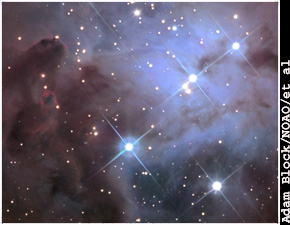Everyone has looked into the Western sky just before sunset, or the Eastern sky just before dawn and seen what appears
to be a brilliant jewel in the sky. Depending on the time of year, Venus can appear in either place. It is the most visible
of the planets, being the most easy to pick out of the night sky. It can be observed through binoculars or a small telescope
and be spectacular.
Venus, named for the Roman goddess of beauty and love, looks like an idea world, however looks
can be decieving. With a thick atmosphere of carbon monoxide, Venus has a greenhouse effect gone wild. Temperatures
on Venus can reach 860 degrees Fahrenheit, the hottest in our solar system! Even at night the temperature barely changes.
Its desert like surface is devoid of the craters like that of Mercury, suggesting that Venus has been resurfaced by the many
volcanoes littering the surface.
When observing Venus you will notice that it takes on a crescent shape much like our own Moon.
This is due to the fact that it lies between us and the Sun.

